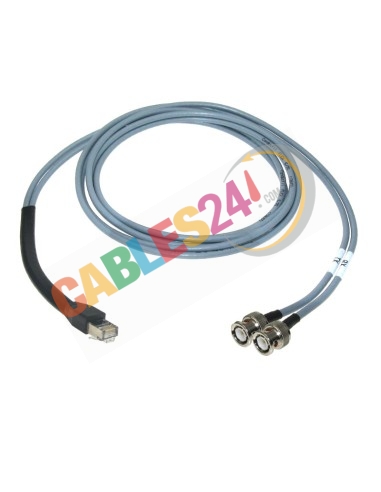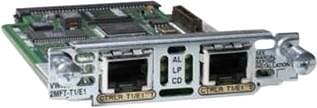CAB-E1-RJ45BNC Cisco RJ45-Dual BNC E1 Cable 72-1338-01 Unbalanced, 3m
Cisco Third-Generation 1-, 2-, and 4-Port T1/E1 Multiflex Trunk Voice/WAN Interface Cards
These flexible interface cards support multiple integrated data, voice and video applications, facilitating the migration from data only as well as circuit-switched voice/video services to a packet voice/video solution
Introduction
The Cisco ® Third-generation 1-, 2-port and 4-port T1/E1 Multiflex Trunk Voice/WAN Interface (MFT VWIC3s) support data and voice applications on the Cisco 1921, 1941 and 1941W (data only), and the Cisco 2901, 2911, 2921, 2951, 3925, 3945, 3925E and 3945E Integrated Services Routers. The Cisco MFT VWIC3 combines WAN-interface-card (WIC) and voice-interface-card (VIC) functions to provide unparalleled flexibility, versatility, and investment protection through its many uses. Customers who choose to integrate data and voice in multiple steps preserve their investment in a T1/E1 WAN interface because the Cisco MFT VWIC3 cards can be reused in packet voice applications. The 2 port T1/E1 MFT VWIC3 is shown below.
Figure 1. Cisco 1-,2- and 4-Port T1/E1 MFT VWIC3
The Cisco MFT VWIC3 interface cards add improvements over the Cisco Second-generation 1- and 2-port T1/E1 Multiflex Voice/WAN Interface Cards (MFT VWIC2s). The Cisco 2- and 4-port MFT VWIC3s enable each port to be clocked from an independent clock source for data applications. Voice applications can now be clocked independently from data applications, with all ports for voice applications clocked from a single source. The Cisco MFT VWIC3s use the ECAN on the motherboard PVDM cards with up to 128ms echo-tail length for demanding network conditions. MFT VWIC3 cards support up to 2 channel groups per T1/E1 port for serial data applications. Refer to Table 3 for all configuration options offered with the MFT VWIC3 cards.
The Cisco MFT VWIC3 cards can be inserted into the EHWIC slot on the supported Cisco 1921, 1941, 1941W, 2901, 2911, 2921, 2951, 3925, 3945, 3925E and 3945E integrated services routers. The T1/E1 MFT VWIC3 cards support both T1 and E1, providing additional flexibility in configuring the Cisco MFT VWIC3s for supporting T1, fractional T1, E1, and fractional E1 for both voice and WAN applications. All MFT VWIC3 modules include the drop-and-insert multiplexing capability, which eliminates costly external third-party channel service units/data service units (CSUs/DSUs) and drop-and-insert multiplexers.
Cisco Second-Generation 1- and 2-Port T1/E1 Multiflex Trunk Voice/WAN Interface Cards Data Sheet
This flexible, multiservice solution supports multiple data, voice, and integrated data and voice applications, facilitating the migration from data only or channelized data and voice to packet voice solutions and simplifying deployment, management, and sparing.
Introduction
The Cisco® Second-Generation 1- and 2-Port T1/E1 Multiflex Trunk Voice/WAN Interface Cards (MFT VWIC2s) support data and voice applications on the Cisco 1721 (data only), 1751, and 1760 Modular Access Routers, the Cisco 2600XM Multiservice Router, the Cisco 2691 Multiservice Platform, the Cisco 3662 Telco Versatile DCN Access Platform, the Cisco 3725 and 3745 Multiservice Routers, and the Cisco 1841 (data only), 2801, 2811, 2821, 2851, 3825, and 3845 Integrated Services Routers (ISRs). The Cisco MFT VWIC2 combines WAN-interface-card (WIC) and voice-interface-card (VIC) functions to provide superior flexibility, versatility, and investment protection through its many uses. Customers who choose to integrate data and voice in multiple steps preserve their investment in a T1/E1 WAN interface because the Cisco MFT VWIC2 cards can be reused in packet voice applications. The 2-port T1/E1 MFT VWIC2 is shown in Figure 1.
Figure 1. Cisco 2-Port T1/E1 MFT VWIC2 (part number VWIC2-1MFT-T1/E1)
The Cisco MFT VWIC2 interface cards add numerous improvements over the Cisco 1- and 2-Port T1/E1 Multiflex Voice/WAN Interface Cards (MFT VWICs). The MFT VWIC2 cards have an onboard slot for a Cisco MFT Dedicated Echo Cancellation (ECAN) Module (part number ECMFT- 32 or EC-MFT-64), offering an enhanced echo-cancellation capability for demanding network conditions. The T1/E1 MFT VWIC2 cards support both T1 and E1, providing additional flexibility in configuring the Cisco MFT VWIC2s for supporting T1, fractional T1, E1, and fractional E1 for both voice and WAN applications. All MFT VWIC2 modules now include the drop-and-insert multiplexing capability, which eliminates costly external third-party channel service units/data service units (CSUs/DSUs) and drop-and-insert multiplexers. The Cisco 2-port MFT VWIC2s also can enable each port to be clocked from independent clock sources for data applications. This independent clocking capability is not supported for voice applications or with the Cisco ATM/Voice Advanced Integration Modules (part numbers AIM-ATM, AIM-VOICE-30, AIM-ATM-VOICE-30).
The Cisco MFT VWIC2 cards can either be inserted into the WIC, VWIC, and high-speed WIC (HWIC) slots on the supported Cisco 1721, 1751, 1760, 1841, 2600XM, 2691, 2801, 2811, 2821, 2851, 3662, 3725, 3745, 3825, and 3845 access routers, or they can be used in the VWIC slot(s) on the Cisco Digital T1/E1 Packet Voice Trunk Network Module (NM-HDV), IP Communications High-Density Digital Voice/Fax Network Modules (NMHDV2), IP Communications High-Density Digital Voice Network Module with 1 T1/E1 slot (part number NM-HDV2-1T1/E1), IP Communications High-Density Digital Voice Network Module with 2 T1/E1 slots (part number NM-HDV2-2T1/E1), 2-slot IP Communications Enhanced Voice/Fax Network Modules (NM-HD- 2VE), WAN Card Slot Network Module with 2 slots (NM-2W), 10/100 Ethernet 1 4/16 Token Ring 2 WAN Card Slot Network Module with 2 slots (NM-1FE1R2W), 10/100 Ethernet 2 WAN Card Slot Network Module with 1 slot (NM-1FE2W-V2), or 10/100 Ethernet 2 WAN Card Slot Network Module with 2 slots (NM-2FE2W-V2) when used with a supported access router.




